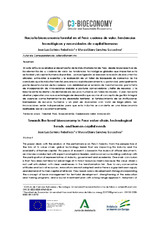Hacia la bioeconomía forestal en el Perú: cadena de valor, tendencias tecnológicas y necesidades de capital humano
Towards the forest bioeconomy in Peru: value chain, technological trends, and human capital needs
Autor
Solleiro Rebolledo, José Luis
Sánchez Goicochea, Myrsia
Editor
Universidad de Córdoba, UCOPressFecha
2021Materia
ForestalPerú
Bioeconomía
Cadena de valor
Innovación
Forest
Bioeconomy
Value chain
Innovation
METS:
Mostrar el registro METSPREMIS:
Mostrar el registro PREMISMetadatos
Mostrar el registro completo del ítemResumen
En este artículo se analiza el desempeño de la industria forestal de Perú, desde la perspectiva de los elementos de su cadena de valor, las tendencias tecnológicas globales que impactan esta actividad y el capital humano disponible. La investigación se basa en la revisión de documentos oficiales, entrevistas a expertos y la realización de un taller de búsqueda de consenso. Se ha concluido que la industria forestal peruana no explota plenamente su potencial, principalmente por la desarticulación de la cadena, con debilidad en el eslabón de transformación; por la falta de incorporación de innovaciones debida a posturas conservadoras y falta de recursos; y la brecha entre la oferta y la demanda de recursos humanos en todos los niveles. El país necesita diseñar y ejecutar una nueva estrategia de desarrollo que asuma el concepto de gestión integral de cuencas como herramienta de desarrollo territorial, el fortalecimiento de las instituciones formadoras de recursos humanos y un plan de inversiones con visión de largo plazo. Las innovaciones serán indispensables para que esta industria se convierta en una bioeconomía redituable social y económicamente. This paper deals with the analysis of the performance on Peru’s forestry, from the perspective of the links of its value chain, global technology trends that are impacting this industry and the availability of human capital. This piece of research is based in the review of official documents, an interview conducted with experts and opinion leaders, and a consensus-building workshop with the participation of representatives of industry, government and academia. One main conclusion is that Peru does not take full advantage of its forest resources mainly because the value chain is not well articulated, with clear weaknesses in the transformation link. Due to very conservative attitudes and lack of resources, innovations are not adopted; and a there is a gap between supply and demand of human capital at all levels. Peru needs a new development strategy incorporating the concept of basin management for territorial development, strengthening of the education and training programs, and a sound investment plan with a long range approach. Adoptions of innovations along the value chain is critical for Peru to make the transition to a forest bioeconomy able to yield positive socioeconomic impacts

